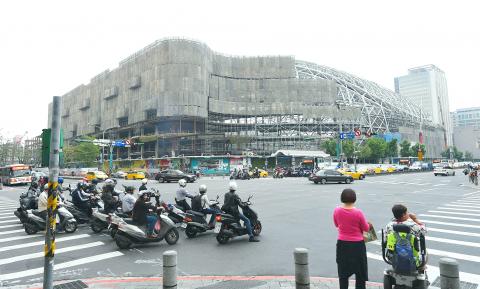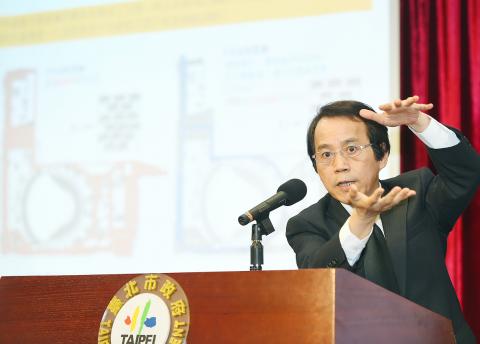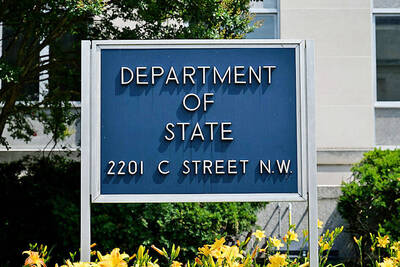Either the Taipei Dome (台北大巨蛋) or its neighboring shopping mall should be demolished, Taipei Deputy Mayor Charles Lin (林欽榮) said yesterday, as he presented the results of the city’s safety inspection commission into the Dome’s evacuation plans.
Computer analysis of the evacuation plans found that the construction of a large shopping mall adjoining the Dome would prevent the site from being evacuated within 15 minutes.
In addition to increasing the difficulty of evacuating the Dome itself, the city’s computer model found that the shopping mall would be difficult to evacuate, with exits remaining clogged a full hour after an evacuation began.

Photo: Chang Chia-ming, Taipei Times
Lin attributed the results to overbuilding on the construction site by contractor Farglory Land Development Co (遠雄建設), with the area occupied by buildings increasing from 46 percent in the initial plan put forward in 2004 to 54.5 percent at present.
“An area equal to five Sogos has been added to the complex,” Lin said, referring to the Taipei Pacific Sogo Department Store (太平洋崇光百貨) shopping mall. “Excessive additional building space has caused the Taipei Sports and Cultural Park to become highly dangerous and a potential disaster area.”
He said that the city’s analysis found that the open space surrounding the Dome complex could only hold 60,000 people, far fewer than the estimated 140,000 people who could be inside the buildings during an emergency.

Photo courtesy of the Taipei City Government
He added that the lack of space would also prevent fire trucks from attending a disaster at the site.
“The site design would crowd everyone onto [neighboring] Guangfu S Road and Zhongxiao E Road,” Lin said. “In that event, how can rescue operations be conducted?”
Lin said that while the city “respected” the Ministry of the Interior Construction and Planning Agency’s approval of site safety plans, it questioned whether a truly rigorous analysis had been conducted, given the lack of clear national standards for evaluating a structure as large as the Taipei Dome.

Photo: Chang Chia-ming, Taipei Times
He said Farglory had failed to conduct a comprehensive analysis of evacuation procedures for the entire complex, while setting an unrealistic evacuation objective of having all of the spectators out of their seats within eight minutes in a “preliminary” evacuation, compared with the 15-minute complete evacuation standard used in Japan.
Lin said that Farglory also incorporated other numerous problematic assumptions into their model, including failing to take into consideration the obstacle Dome seating would present to fleeing spectators.
He said the firm made an unrealistic calculation of how quickly fleeing spectators would be able to escape the structure and also inflated the amount of “open space” around the structure by incorporating stairways and failing to subtract space which would be needed for rescue operations.
While Farglory’s analysis only involves an “ordinary” evacuation, the city conducted an “emergency” analysis, he said.
Lin also cited the ease with which a fire could spread throughout the complex as a major concern, calling the two stories of parking beneath the site which connects the different buildings “unprecedented.”
A fire within the parking lot would be extremely difficult to reach and extinguish, while it could easily spread throughout the complex, he said.
Given the safety problems unearthed, the commission recommended that either the Dome itself or the neighboring mall should be demolished to provide more open space for an emergency evacuation, he said, adding that the site’s underground parking should also be sealed off.
The complex’s other buildings would be unaffected.
Lin declined to comment on the effect the city’s report would have on ongoing negotiations with Farglory, adding that the negotiations were the responsibility of a separate committee headed by Deputy Mayor Teng Chia-chi (鄧家基).
Teng refused to respond to reporters’ questions, instead releasing a statement saying that as long as there were public safety concerns the city would not allow the complex to begin operations.
The Taipei City Government launched a safety investigation into the Dome after Farglory refused to agree to demands for concessions during a renegotiation of the terms of the contract.
The Taipei Department of Sports said that the Taipei Gymnasium could serve as the main site for the 2017 Universiade if the Taipei Dome is unavailable.

A car bomb killed a senior Russian general in southern Moscow yesterday morning, the latest high-profile army figure to be blown up in a blast that came just hours after Russian and Ukrainian delegates held separate talks in Miami on a plan to end the war. Kyiv has not commented on the incident, but Russian investigators said they were probing whether the blast was “linked” to “Ukrainian special forces.” The attack was similar to other assassinations of generals and pro-war figures that have either been claimed, or are widely believed to have been orchestrated, by Ukraine. Russian Lieutenant General Fanil Sarvarov, 56, head

SAFETY FIRST: Double the number of police were deployed at the Taipei Marathon, while other cities released plans to bolster public event safety Authorities across Taiwan have stepped up security measures ahead of Christmas and New Year events, following a knife and smoke bomb attack in Taipei on Friday that left four people dead and 11 injured. In a bid to prevent potential copycat incidents, police deployments have been expanded for large gatherings, transport hubs, and other crowded public spaces, according to official statements from police and city authorities. Taipei Mayor Chiang Wan-an (蔣萬安) said the city has “comprehensively raised security readiness” in crowded areas, increased police deployments with armed officers, and intensified patrols during weekends and nighttime hours. For large-scale events, security checkpoints and explosives

PUBLIC SAFETY: The premier said that security would be tightened in transport hubs, while President Lai commended the public for their bravery The government is to deploy more police, including rapid response units, in crowded public areas to ensure a swift response to any threats, President William Lai (賴清德) said yesterday after a knife attack killed three people and injured 11 in Taipei the previous day. Lai made the remarks following a briefing by the National Police Agency on the progress of the investigation, saying that the attack underscored the importance of cooperation in public security between the central and local governments. The attack unfolded in the early evening on Friday around Taipei Main Station’s M7 exit and later near the Taipei MRT’s Zhongshan

REBUFFED: In response to Chinese criticism over recent arms sales, Washington urged Beijing to engage in meaningful dialogue instead of threats and intimidation Washington’s long-term commitment to Taiwan would not change, the US Department of State said yesterday, urging Beijing to stop pressuring Taiwan and engage in meaningful bilateral dialogues. The remarks came in response to a backlash from Beijing about Washington’s latest approval of arms sales to Taiwan. The US Defense Security Cooperation Agency said in a statement on Wednesday that the Taipei Economic and Cultural Representative Office in the US has asked to purchase an arms package, including Tactical Mission Network Software; AH-1W helicopter spare and repair parts; M109A7 self-propelled howitzers; HIMARS long range precision strike systems; tube-launched, optically tracked, wire-guided missiles; Javelin